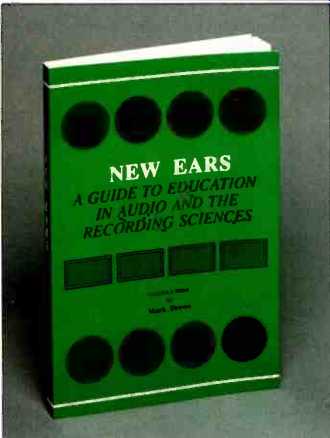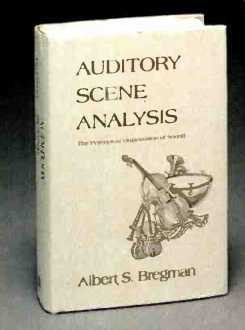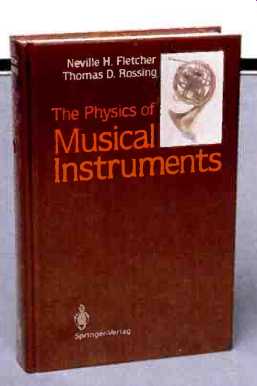BASIC EDUCATION

New Ears: A Guide to Education in Audio and the Recording Sciences, compiled and edited by Mark Drews. New Ear Productions, softcover, 208 pp., $11.95. (Available from New Ear Productions, 1033 Euclid Ave., Syracuse, N.Y. 13210.)
Your clock radio turns on at 6:00 a.m. like, well, like clockwork, playing a medley of early Beatles tunes-not a bad way to start a morning. While heating up a bagel, there's just enough time to catch the TV news, with sound bites from Washington, New York, and the Persian Gulf. Traffic's not too bad today, but your CD changer is still a comfort, with your eclectic collection of driving music. They are paging you even as you walk into the office, and your phone doesn't stop ringing all day. Fortunately you've got two tickets to Die Walküre tonight--that should be a welcome relief.
Clearly, the benefits and distractions of audio technology are all around us, from clock radios to car stereos, from telephones to opera house acoustics.
All are examples of a profession that combines art and engineering to bring us everything from the commerce of voice to the joy of music. More specifically, all of that exists thanks to the thousands of audio professionals practicing their craft in broadcasting studios, recording studios, manufacturing plants, consulting firms, and even editorial offices.
Yet most of these professionals have come to audio by a circuitous route, through electrical engineering colleges, electronics trade schools, military training, music performance, or even from an entirely unrelated field of study. Until recently, there were no education programs specifically designed to train audio professionals.
That has changed, as a wide variety of academic and trade school curricula have been developed to meet the growing need for skilled personnel in audio professions.
In fact, the large number of programs, and their diversity, has made it difficult for prospective students to find the program best suited to their backgrounds and aspirations. Recognizing this problem, Mark Drews has compiled a directory of audio education programs and published it as New Ears: A Guide to Education in Audio and the Recording Sciences. In its 208 pages, it profiles over 80 programs and provides a master list of more than 320 audio-related programs at universities, trade schools, and education workshops in North America and worldwide, ranging from short courses to graduate study.
A wealth of information is provided on the profiled programs, including degrees offered, program length, tuition, class size, financial aid, admissions policy, and specific course offerings.
Using this consistently presented database, it is easy to compare programs and identify their strengths and focus. In this way, prospective students can quickly find the program best suited to their needs. The master directory of programs is given alphabetically by state and country. This is convenient for locating programs in a specific geographical area and in identifying programs not profiled. The book also contains directories of audio publishers, magazines and journals, professional industry associations, and suggested books, plus a useful bibliography and even some words of wisdom based on the author's own experiences as a music engineering student at the University of Miami.
Of course, any book grows obsolete after it is published, and New Ears is no exception. Since it was published in 1989, changes have taken place in the field of audio education. Fortunately, with the many phone numbers and addresses supplied, it would be an easy matter for a prospective student to contact a listed institution for the latest information.
Anyone interested in pursuing a career in audio engineering, music recording, or a related field should start a search for appropriate education with New Ears. It will save you many hours of do-it-yourself research and provide a concise, consistent summary that makes comparison shopping easy. Given the high cost of education, and the low cost of this comprehensive book, it may be the smartest decision you'll make.
-Ken C. Pohlmann
--------------

Auditory Scene Analysis: The Perceptual Organization of Sound by
Albert S. Bregman. A Bradford Book, The MIT Press, hardcover, 773 pp.,
$55.00.
The study of hearing, long the province of researchers absorbed in the plotting of sensory thresholds, discrimination functions, scaling functions, and the like, is broadening into a new and exciting area of research, made possible by recent developments in audio technology. Armed with the ability to synthesize virtually any time-varying sound signal that can be imagined, to digitize naturally produced sounds, store them in computer memory, and analyze and transform them in numerous ways, researchers are at last coming to grips with the difficult yet central problems of sound perception.
For example, suppose that you are listening to a symphony in a concert hall. The mixture of sounds that reaches your ears is produced by many instruments playing simultaneously. What principles does the hearing mechanism use to sort out this mixture of sounds, so that we identify the violins as playing one melodic line, the cellos another, and the flutes another? We do this with such apparent ease that one might assume the perceptual task to be a simple one. Yet there is no computer system in existence that can perform such an analysis reliably.
To take another example, you pick up the telephone and immediately recognize a friend's voice at the other end of the line. Yet this is the first time you have ever heard this particular sound spectrum. What are the cues that enable us to recognize a specific sound quality such as this, even in the face of considerable signal distortion? This task also appears deceptively simple, yet at present we do not know how it is accomplished.
Albert S. Bregman's Auditory Scene Analysis provides an up-to-date and comprehensive account of research and theory in this field. It focuses primarily on Bregman's own very interesting work, but also draws on that of other psychologists and related work by computer scientists and musicians.
The book contains over 700 pages, which are packed with information concerning details of lab experiments, debates over their interpretation, and theoretical speculations. There are lengthy explorations of the primitive grouping principles by which we link together components of the ongoing acoustic spectrum-frequency proximity, temporal proximity, spatial location, similarity of timbre, and so on.
Then there are explorations of what psychologists call "top-down" or "schema-driven" processes in auditory perception--the uses made by the hearing mechanism of past experience with sounds. Other sections of the book deal with the applications of these principles to the perception of particular classes of sound, for example those of speech and music.
This book is not for casual reading. The arguments are so synthesized and intermixed that you really have to read it from beginning to end in order to develop a clear understanding of Bregman's view. But for those prepared to devote the time, Auditory Scene Analysis contains much valuable information and food for thought.
---Diana Deutsch

The Physics of Musical Instruments by Neville H. Fletcher
and Thomas D. Rossing. Springer-Verlag, hardcover, 620 pp., $69.00.
While Neville Fletcher may be a new name to most of us, Thomas Rossing is well known in the United States for his excellent textbook, The Science of Sound, and for his contribution to the Auditory Demonstrations CD, which is distributed by the Acoustical Society of America.
Fletcher and Rossing state that their new book is addressed to a reader "with a reasonable grasp of physics and who is not frightened by a little mathematics." A further aim has been to bridge the gap between the many books that treat musical instruments largely in a graphical and historical way and the body of detailed quantitative analysis normally found in scientific journals. The book certainly succeeds in this regard.
The authors lay a rigorous foundation on which to understand the particulars of musical instruments. The first section deals with vibrating systems (in one and two dimensions), coupled systems, and nonlinear systems.
These are, of course, the basic mechanisms for generating and sustaining sounds mechanically and for radiation via sounding boards.
The next section deals with plane and spherical sound waves, level and intensity, and the nature of sound reflection, diffraction, and absorption.
Sound radiation is discussed basically in terms of ideal point, line, and plane sources. Air columns and horns are discussed as a prelude to the discussion of wind instruments.
With the fundamentals covered, the authors move on to string instruments, and the reader who has done his homework, so to speak, is now able to move more or less freely between detailed physical descriptions of instruments and the pertinent mathematical equations. In the third section, both plucked and bowed instruments are discussed in terms of their history, construction, lore, and modes of playing.
Physical descriptions include detailed spectral and directional characteristics of many of the instruments.
Keyboard string instruments are discussed in terms of construction, details of action, tuning, various inharmonicities, unique decay characteristics, and directional properties. Rarely have I seen such detail in descriptions of sounding-board nodal structure and output spectra.
The next major section deals with wind instruments and includes the three orchestral classes of lip reeds (brass), flutes, and woodwind reeds.
As in earlier sections, the descriptions of instrumental output spectra and directional properties are richly detailed. The pipe organ is given special treatment here.
In the percussion section, instruments are divided into the categories of drums (membranophones), mallet instruments (tuned xylophones and metallophones), cymbals, gongs, plates and steel drums (untuned metallophones), and bells.
All in all, the book presents a fine balance between mathematical rigor, graphical detail, and verbal description. The book can function as a specialized text at the upperclassman or graduate level, but the intuitive clarity of so many of the graphs and descriptions recommends this work as a broad source of information for the reader who may, in fact, be frightened by a little mathematics!
-John Eargle
(adapted from Audio magazine, Jan. 1992)
= = = =